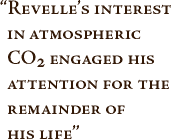

After receiving his bachelor's degree from Pomona in 1929, Revelle entered the University of California-Berkley to continue his studies in geology. In 1931, at the recommendation of his major professor, George Davis Louderback, he received a research assistantship in oceanography at the Scripps Institute of Oceanography in La Jolla, California. While at Scripps, Revelle participated in a number of nautical expeditions on the SCRIPPS, the institute's small research vessel, and as a guest on ships of the U.S. Coast and Geodetic Survey and U.S. Navy. In 1936, after the completion of his dissertation, "Marine Bottom Samples Collected in the Pacific Ocean by the CARNEGIE on its Seventh Cruise," Revelle was awarded his Ph.D. and immediately appointed oceanography instructor at Scripps. Revelle served in the U.S. Navy during World War II as the commander
of the oceanographic section of the Bureau of Ships and became head of
their geophysics branch in 1946. He returned to Scripps in 1948 and
served as its director from 1951 to 1964. Over the course of his
directorship, Revelle held numerous positions and appointments,
including chairman of the Panel on Oceanography of the U.S. National
Committee on the International Geophysical Year (IGY). During the
planning phase for the IGY, Scripps was designated as a participant, and
then later as the principal center, in the Atmospheric Carbon Dioxide
Program. In July 1956, Charles David Keeling joined the Scripps staff
to head the program and began measurements of atmospheric carbon dioxide
at Mauna Loa, Hawaii, and Antarctica. Revelle's interest in the program
grew and he planned to investigate the general carbon cycle and the
solubility of calcium carbonate. |
 On the Shoulders of Giants | ||
 |
In 1957, Revelle and Hans Suess, one of the founders of radiocarbon dating, demonstrated that carbon dioxide had increased in the air as a result of the use of fossil fuels in a famous article published in Tellus, a European meteorology and oceanography journal. Revelle's interest in atmospheric carbon dioxide engaged his attention for the remainder of his life. He brought the subject to the attention of the public as a member of the President's Science Advisory Committee Panel on Environmental Pollution in 1965. Under Revelle's leadership, the committee published the first authoritative U.S. government report in which carbon dioxide from fossil fuels was officially recognized as a potential global problem. Revelle chaired the National Academy of Sciences Energy and Climate Panel in 1977, which found that about forty percent of the anthropogenic carbon dioxide has remained in the atmosphere, two-thirds of that from fossil fuel, and one-third from the clearing of forests. next: Public Policy
| ||